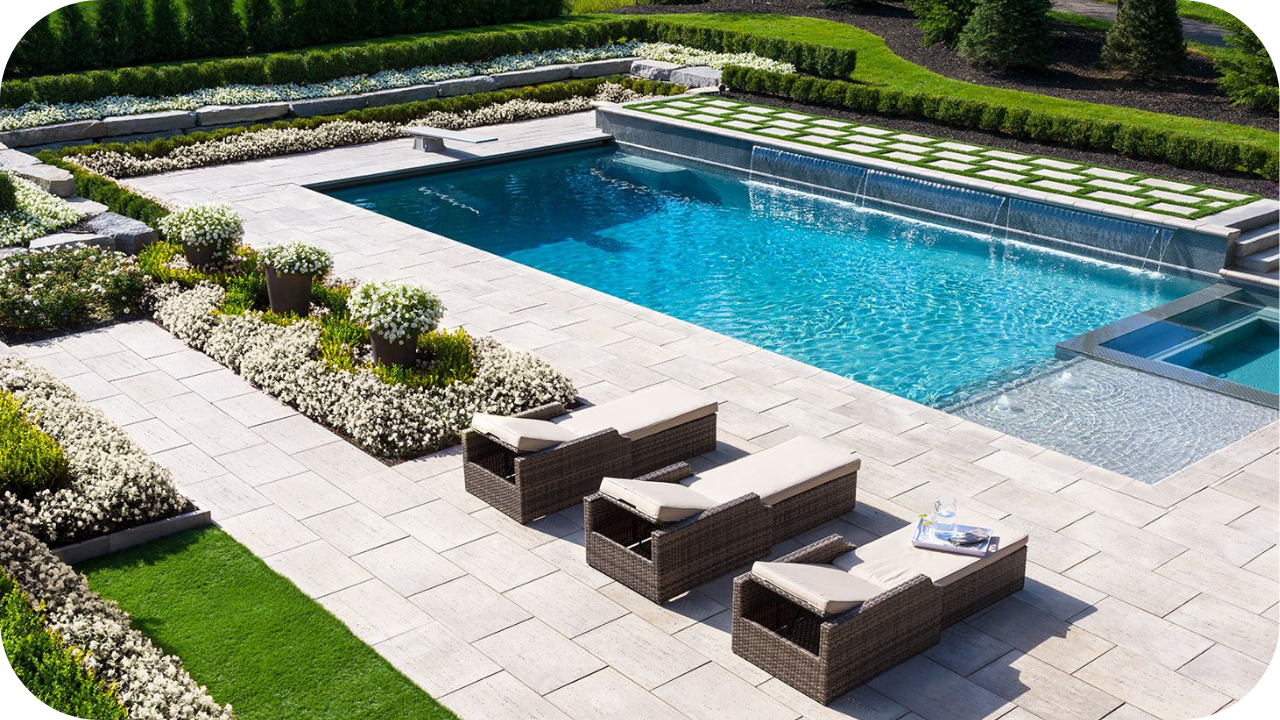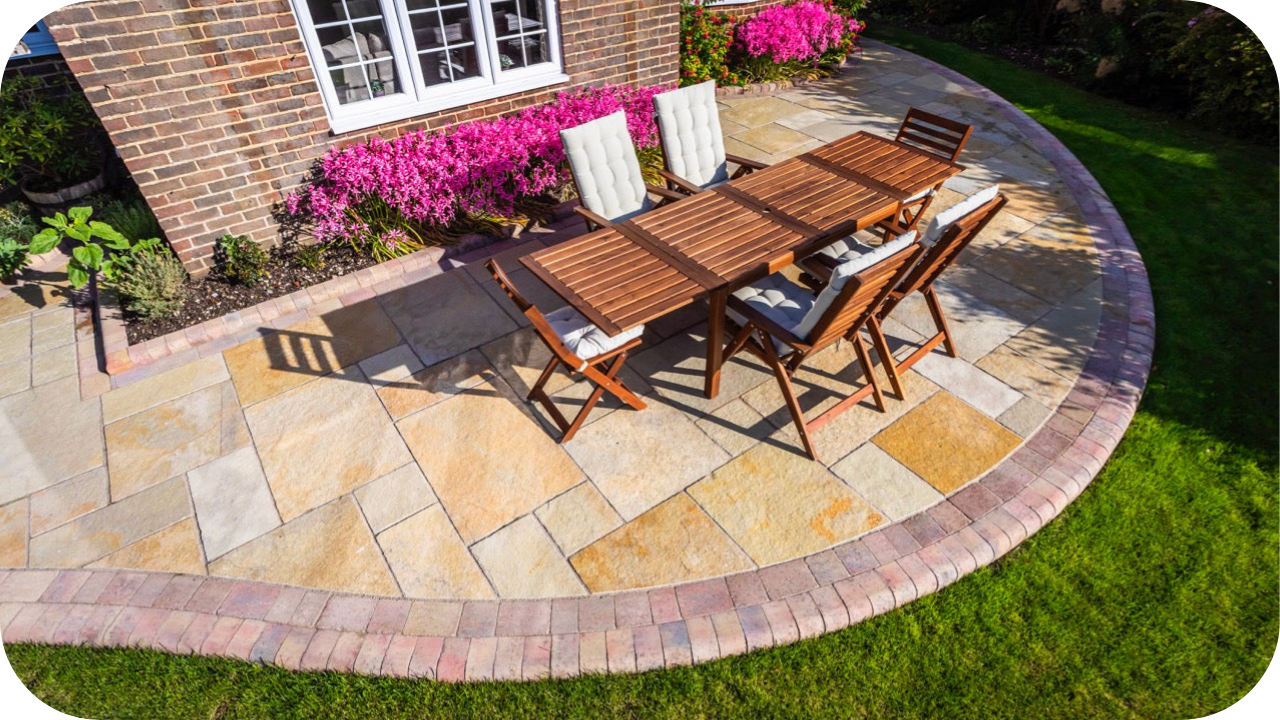
Creating a stunning walkway or path in your garden involves more than just laying down a few stones or bricks.
Enhancing your outdoor space’s functionality and aesthetics requires careful planning, selecting suitable materials, and a thoughtful design.
This comprehensive guide will explore various materials and designs to help you create the perfect walkway or path for your garden.
Best Walkway And Path Hardscaping Ideas
Transform your outdoor space into a stunning retreat with these walkway and path hardscaping ideas. Whether you desire a rustic garden path or a sleek modern walkway, these options provide both functionality and aesthetic appeal:
1. Bluestone Paths
Enhance your outdoor space with the timeless elegance of bluestone paths. Known for its durability and sophisticated appearance, bluestone is a popular choice for homeowners seeking both functionality and aesthetic appeal in their walkways.
Bluestone is a natural stone in shades of blue, grey, and green, offering a versatile colour palette to complement any landscape design. Its dense composition makes it incredibly durable and able to withstand heavy foot traffic and harsh weather conditions, ensuring a long-lasting path.
Installation options for bluestone paths are diverse. You can choose between irregular flagstone pieces for a more rustic look or cut bluestone pavers for a sleek, modern design. The stone’s naturally rough texture provides excellent slip resistance, making it a safe walkway choice.
Bluestone paths require straightforward maintenance. Regular sweeping and occasional power washing keep the stones looking their best. Over time, the natural weathering process enhances the stone’s charm and beauty. Bluestone paths not only add visual appeal but also increase the value of your property.
2. Sandstone Walkways
Transform your garden with the warm, inviting tones of sandstone walkways. Sandstone is a popular choice for outdoor paths due to its natural beauty, durability, and versatility, making it ideal for various landscape designs.
Sandstone is available in various colours, including shades of tan, brown, yellow, red, and grey, allowing you to match or complement your existing outdoor décor. Its subtle, earthy hues blend seamlessly with natural surroundings, creating a harmonious and aesthetically pleasing path.
One critical advantage of sandstone is its durability. This natural stone can withstand significant wear and tear, making it suitable for areas with heavy foot traffic. Its slightly rough texture also provides good slip resistance, ensuring safe passage even in wet conditions.
Sandstone walkways offer installation flexibility. The stones can be cut into regular pavers for a uniform look or left irregular for a more rustic, natural appearance. Sandstone is relatively easy to work with, making it a favourite among landscapers and DIY enthusiasts.
Sandstone requires minimal maintenance. Regular sweeping and occasional rinsing with water is usually sufficient to keep the stones looking their best. Over time, the natural weathering process enhances its character, adding to its charm.
Sandstone walkways enhance your garden’s visual appeal and add value to your property. Their blend of beauty, resilience, and easy maintenance makes them an excellent choice for any outdoor space.
3. Stone Slab Paths
Create a stunning and durable walkway with stone slab paths. Known for their elegance and robustness, stone slabs are a top choice for homeowners looking to add a touch of sophistication to their outdoor spaces.
Stone slab paths are made from large, flat pieces of natural stone, such as granite, limestone, or slate. These slabs offer a sleek and seamless look, perfect for modern and traditional landscape designs. Their substantial size and weight provide a solid, stable walking surface that can withstand heavy foot traffic and weather conditions.
One of the primary advantages of stone slab paths is their aesthetic appeal. The natural variations in the colour and texture of the stone create a unique and eye-catching pathway that enhances the beauty of any garden or yard. Stone slabs can be laid in various patterns, from simple linear arrangements to more intricate designs, allowing for creative customisation.
Installation of stone slab paths requires careful planning and precision. Proper ground preparation and a sturdy base are essential to ensure the path’s longevity and stability. Once installed, stone slabs require minimal maintenance. Regular sweeping and occasional rinsing with water are usually sufficient to keep them looking pristine.
4. Stepping Stones
Enhance your garden’s charm with the simple yet elegant addition of stepping stones. These versatile path elements create an inviting and natural look, seamlessly blending with various landscape styles.
Stepping stones are made from various materials, including natural stone, concrete, and wood. Each offers a distinct aesthetic, from the rustic appeal of natural stone to the modern, clean concrete lines. The choice of material can significantly influence the overall look of your garden path.
The layout of stepping stones is highly flexible. Space them out to create a leisurely, meandering path or place them closer together for a more formal walkway. This flexibility allows creative designs that adapt to your garden’s specific contours and features.
Installing stepping stones is relatively straightforward, making them a popular choice for DIY enthusiasts. Begin by placing the stones in your desired pattern, then secure them by embedding them slightly into the ground. Ensure the surface is level to provide a stable walking path.
Stepping stones require minimal maintenance. Regular sweeping and occasional rinsing with water will keep them looking their best. Over time, they may develop a natural patina, adding to their charm and integrating them further into the landscape.
5. Paver Walkways
Transform your outdoor space with the versatility and durability of paver walkways. Pavers are famous for creating attractive, long-lasting paths that suit various landscape styles.
Pavers are made of many materials, including concrete, brick, and natural stone. Each material offers unique aesthetic qualities, from the clean lines of concrete pavers to the rustic charm of brick and the natural elegance of stone. This variety allows for extensive customisation to match your specific design preferences.
One of the main advantages of paver walkways is their modular nature. Pavers are available in numerous shapes, sizes, and colours, enabling intricate patterns and designs. Common patterns include herringbone, basket weave, and running bond, each adding a distinct visual appeal to your walkway.
Installation of paver walkways requires a well-prepared base to ensure stability and longevity. The process involves laying a compacted gravel and sand foundation, followed by the precise placement of pavers. This method provides a durable and level surface capable of withstanding heavy foot traffic and varying weather conditions.
Maintenance of paver walkways is straightforward. Regular sweeping and occasional washing with water keeps the path clean. Should a paver become damaged, it can be easily replaced without disturbing the surrounding area, making repairs simple and cost-effective.
6. Cobblestone Paths
Add a touch of timeless charm to your garden with cobblestone paths. Renowned for their old-world appeal and durability, cobblestones are an excellent choice for creating elegant and enduring walkways.
Cobblestones are made from natural stones like granite, basalt, or limestone. These materials are known for their exceptional strength and ability to withstand heavy foot traffic and adverse weather conditions. The natural variations in colour and texture of cobblestones add to their unique and classic look.
Installing cobblestone paths involves laying individual stones in a bed of sand or mortar. This method ensures a stable and long-lasting path. The rocks can be arranged in various patterns, such as a traditional running bond or a more intricate fan or circular design, allowing for creative expression in your walkway.
One of the critical benefits of cobblestone paths is their low maintenance requirements. Regular sweeping and occasional rinsing with water is typically sufficient to keep the path looking pristine. The durability of cobblestones means they rarely need replacement, and any necessary repairs are straightforward, involving the replacement of individual stones.
7. Concrete Walkways
Enhance your landscape with the sleek and modern appeal of concrete walkways. Known for their durability and versatility, concrete paths offer a practical and aesthetically pleasing solution for various outdoor spaces.
Concrete walkways are highly durable and withstand heavy foot traffic and harsh weather conditions. Their robust nature ensures a long-lasting path that requires minimal maintenance. Regular sweeping and occasional washing with water is sufficient to keep the walkway looking its best.
One of the main advantages of concrete walkways is their versatility in design. Concrete can be poured into various shapes and sizes, allowing for customisable pathways that fit the unique contours of your landscape.
Additionally, concrete can be stamped, stained, or coloured to mimic the appearance of more expensive materials like brick, stone, or tile, providing a cost-effective alternative without sacrificing visual appeal.
Installing concrete walkways involves preparing a stable base, constructing forms to hold the concrete in place, and then pouring and finishing the concrete surface. This process ensures a smooth and even path that can be customised with different textures and patterns.
Concrete walkways are an excellent investment for any property. Their strength, low maintenance, and design flexibility make them famous for creating functional and attractive outdoor pathways. Whether you prefer a simple, minimalist look or a more elaborate design, concrete walkways can enhance the beauty and functionality of your outdoor space.
Choosing the Right Materials
Selecting the suitable materials for your walkway and path hardscaping is crucial to achieving aesthetic appeal and functionality. The choice of materials can significantly impact your pathway’s durability, maintenance, and overall look.
Firstly, consider the climate and weather conditions in your area. Materials like bluestone and concrete are highly durable and can withstand harsh weather, making them ideal for extreme temperatures or heavy rainfall regions. Sandstone and gravel offer good drainage, suitable for areas prone to moisture.
Next, think about the desired aesthetic. Flagstone and cobblestone provide a rustic, natural look for traditional or cottage-style gardens. Concrete and pavers offer clean lines and customisable designs for a modern, sleek appearance. Brick paths add timeless charm and are versatile enough to suit various styles.
Maintenance is another critical factor. Concrete and paver walkways are low-maintenance options, requiring only regular sweeping and occasional washing. Natural stone paths, while visually appealing, may need more upkeep to prevent moss and weed growth.
Lastly, consider the installation process and budget. Gravel and stepping stones are cost-effective and easier to install, making them suitable for DIY projects. Stone slabs and cobblestones may require professional installation due to their weight and the need for precise placement.
Tips and Tricks For Walkway and Path Hardscaping Ideas
Transform your outdoor space into a stunning landscape with these expert hardscaping tips. Here’s how to craft beautiful, long-lasting walkways and paths:
- Plan Your Pathway: Map out the route, considering natural foot traffic and connections between garden areas. Use stakes and string to visualise the flow.
- Choose the Right Materials: Match materials to your climate, budget, and style. Concrete and bluestone suit high-traffic areas, while gravel and stepping stones provide a casual, affordable alternative.
- Ensure Proper Drainage: Grade the path or integrate a drainage system to avoid water pooling. Opt for materials like gravel and permeable pavers to reduce runoff.
- Prepare a Solid Base: Excavate and lay a compacted gravel base topped with sand or crushed stone for a stable foundation that ensures durability.
- Incorporate Edging: Define paths with bricks, metal strips, or stone borders. Edging keeps materials in place and gives paths a polished appearance.
- Consider Maintenance: Select low-maintenance options for easy care. Regular sweeping and occasional power washing will keep your walkways in top condition.
Installation and Maintenance Tips
Proper installation and maintenance are crucial for ensuring the longevity and beauty of your walkway and path hardscaping.
Here are some essential tips to help you achieve the best results.
- Site Preparation: Start with proper site preparation by marking the pathway layout and excavating the area to the required depth. A solid base is essential; compacted gravel and sand provide stability and drainage.
- Laying the Pathway: Ensure that pavers or stones are placed level and firmly, with even spacing. Use a rubber mallet to tap the materials into place, and fill gaps with sand or mortar.
- Edging: Install edging to keep the pathway materials in place and maintain a clean, defined border. Options include metal strips, bricks, or stone borders.
- Maintenance: Regular maintenance will keep your pathway looking its best. Sweep debris, wash surfaces with water, and check for settling or displacement. Promptly address any issues to prevent further damage.
Conclusion
Transform your outdoor space with these walkway and path hardscaping ideas. From rustic flagstone to sleek concrete, each option enhances beauty and functionality.
Start your project today and create a stunning, durable path that elevates your landscape. For expert advice and quality materials, visit Splendour In Stone and begin your hardscaping journey.
More To Explore

Paving Layouts That Elevate Architectural Plans
The layout of stone paving is more than just a practical decision. It’s a powerful design element that enhances the flow of your space, complements

Thermal Benefits of Stone Pavers in Passive Designs
In passive design, the materials used in a building play a crucial role in regulating temperature. Natural stone pavers are ideal for enhancing thermal performance


